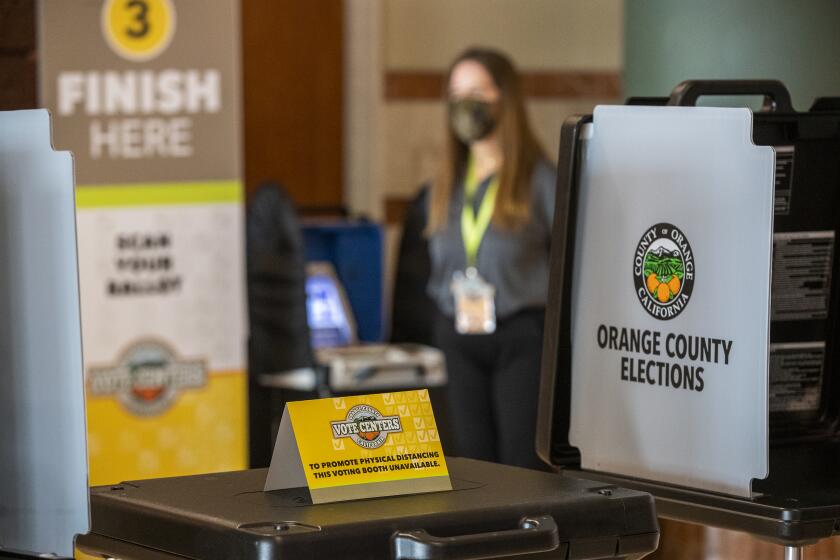In Long Beach, Navy Reservists Begin Coping
- Share via
Kimberly Graftenreed, 23, was forced to give up her Hermosa Beach apartment to cope with the pay cut. San Diego anesthesiologist Winnie Varley-Maneclang, 49, moved in with her daughter in Orange County to lighten the daily commute. And Mohan Vallabhapurapu, 35, missed his chance to serve as a line judge in the U.S. Open tennis tournament, now under way in New York.
They were but three of the 80 Navy reservists who streamed into the Long Beach Naval Hospital Wednesday morning, duffel bags dangling from their shoulders and uncertainty etched on their faces. Dressed in gleaming white uniforms, they had assembled in orderly fashion to help replace 150 doctors, nurses and technicians who have been deployed in the Persian Gulf crisis.
It was a scene that is being repeated in communities across the nation this week as thousands trade civilian lives for active duty in the largest mobilization of the selective reserve since the 1961 Berlin crisis. Almost 50,000 military reservists could be called up by Oct. 1, putting their everyday lives on hold for at least 90 days as the Persian Gulf crisis plays itself out.
The Long Beach reservists, like those elsewhere in the nation, are a diverse lot. Some will earn as little as $895-a-month base pay; a handful will get more than $4,000 a month. They range in age from 19 to 55 and come from all walks of life: a Los Angeles police officer, a real estate agent, a housewife, a nursing college student, a mail carrier, even an embalming assistant from the Los Angeles County coroner’s office.
“To say that your appearance here this morning has been greatly anticipated and much appreciated is the height of understatement,” said the hospital’s commanding officer, Capt. F.G. Sanford, as he greeted the erstwhile “weekend warriors” who assembled in an auditorium at 7:30 a.m.
Most agree that the mobilization will have a dramatic impact on their lives, forcing them to make sacrifices in finances, short-term goals, and in some cases, housing or hairstyles. But they add that these are adjustments that they are prepared--in most cases, quite willingly--to make.
Graftenreed, a pharmaceuticals buyer for the Thrifty Corp., said she had been planning to spend last weekend watching a pro volleyball championship on the shores of the Pacific, within walking distance of her apartment. After receiving a 4 a.m. call-up telephone call last Saturday, she spent her time scurrying for cheaper housing, settling finally for an inland apartment that she will share with a fellow reservist.
“The base pay doesn’t even cover my rent in Hermosa,” explained Graftenreed, who flipped through a copy of Cosmopolitan magazine during slow moments of the orientation. “But patriotically speaking, I feel real good.”
Wednesday’s session began with a long round of bureaucratic form-filling. Laughter permeated the auditorium only once--when a young ensign asked the new charges to check off a box indicating whether they had been activated for duty or shown up on their own.
Next, the reservists received mixed news from Master Chief Phillip Dozier, whose responsibilities include morale and welfare.
Addressing “the quality of life issue,” Dozier announced that tickets will be made available to Disneyland and Dodgers games. But, he added, “eccentric haircuts” are out.
Brian Stringer, 23, a Cal State Long Beach nursing student with a modified pompadour, cringed at the latter announcement. “I guess that means I am going to be going to the barber,” he said later. “It’s just one of those things.”
In the modern day, equal-opportunity Navy, Kellie Hosch was facing a similar problem. Last week, she had gone to a Beverly Hills salon for a spiky hairdo. “I have a faddish hairstyle. Now I’ll have to comb it out like a geek,” she laughed.
Other concerns centered on substance rather than style.
During a brief question-and-answer session, Los Angeles Police Officer Lanita Elias, 23, asked Navy officials whether she can temporarily defer paying bills because of the large pay cut she is facing. “That, unfortunately, will be the lending institutions’ call,” came the unsettling reply.
For the next three months, the reservists, most of whom are members of the Long Beach-based Navy Hospital Reserve Unit 119, will assist in the hospital’s operating room, orthopedics unit and outpatient clinics, Sanford said. In recent days, non-emergency services have been scaled back as seven physicians and more than 140 nurses and technicians have departed to participate in Operation Desert Shield.
Thus far, Varley-Maneclang is the only doctor among those activated to serve at the Long Beach hospital.
“This creates a lot of disturbance and disruption of your regular life,” she said. “But this is what we’re trained for.”
A former Navy officer, the Filipino-born physician is currently a staff anesthesiologist at Kaiser Medical Center in San Diego, where she says she earns $10,000 a month. As a reservist, she will earn less than half that amount.
But Varley-Maneclang seemed less concerned Wednesday about her pay cut than about her new living arrangements--having temporarily traded life with her husband in San Diego for life with her 23-year-old daughter, who lives in La Palma.
“My daughter doesn’t like the idea of my being her roommate,” Varley-Maneclang smiled. “That’s because I have rules.”
A handful of reservists who are reporting to Long Beach from Sacramento, Dallas and Memphis will need temporary housing in barracks, Sanford said. But members of the Long Beach unit--at least those who can afford to--will continue living in their homes, and in certain cases may even receive permission to moonlight to help make ends meet.
For a lucky few, including David Bookrum, the call-up will result in little disruption.
Bookrum, the senior enlisted adviser of Reserve Unit 119, already works at Long Beach Naval Hospital as a civilian risk manager.
“It will be pretty much the same,” he said. “Except now when I get up, I will be putting on a uniform rather than a shirt and tie.”
More to Read
Sign up for Essential California
The most important California stories and recommendations in your inbox every morning.
You may occasionally receive promotional content from the Los Angeles Times.










